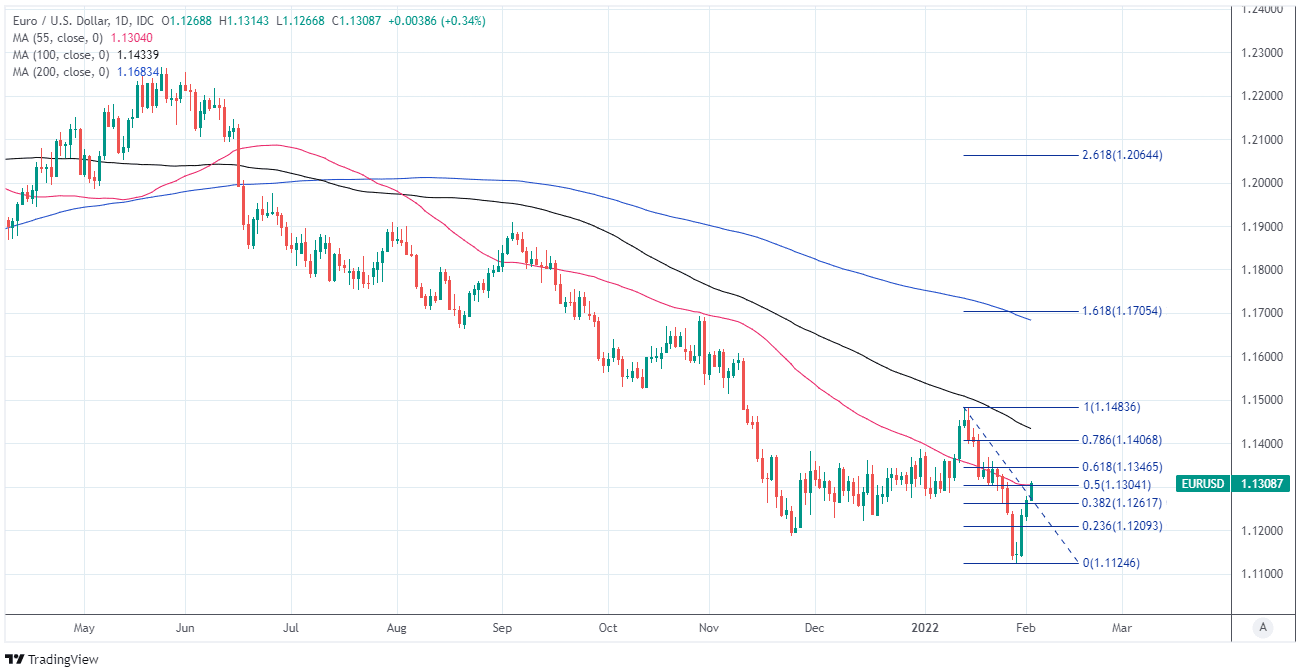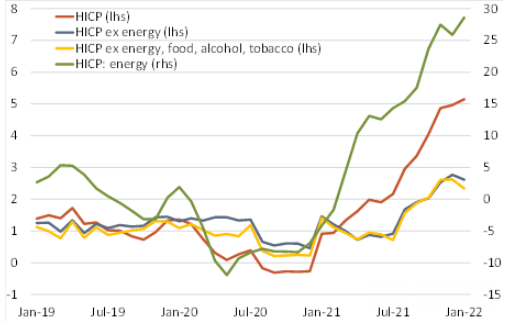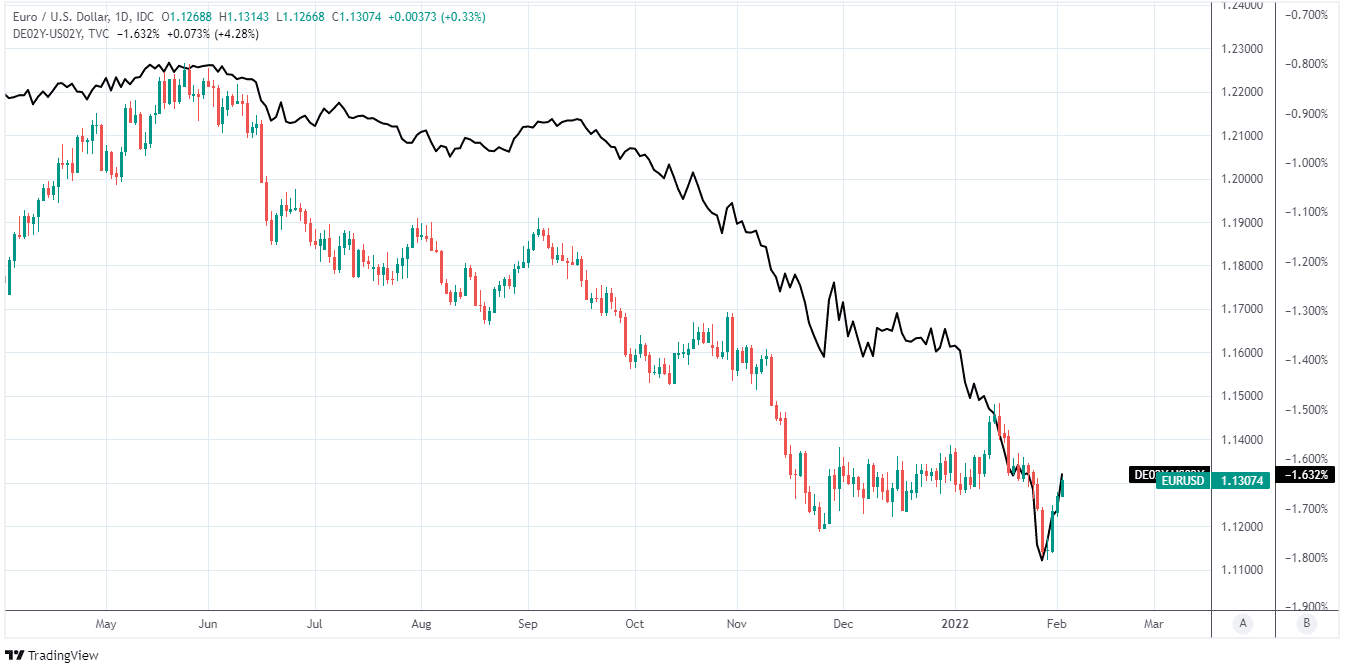Euro / Dollar Jumps Half a Percent on Eurozone Inflation Shock
- Written by: James Skinner
- EUR testing 1.13 as profit-taking weighs on USD
- CPI shock a challenge for ECB & risk to EUR/USD
- New high for CPI hints of persisting inflation risk
- But ECB guidance offers little relief for EUR/USD

Image © Adobe Stock
The Euro to Dollar exchange rate rose to key technical resistance levels in the midweek session after Eurostat’s inflation figures placed the European Central Bank (ECB) under a spotlight ahead of this Thursday’s monetary policy decision.
The Euro rose tentatively above the 1.13 handle as Dollar exchange rates fell broadly in what appeared to be another wave of profit-taking, although the Euro also climbed against other major currencies following the release of inflation data for January.
The Eurozone's inflation rate edged higher from 5% to 5.1% last month in the face of an economist consensus that had looked for it to decline sharply to 4.4%, making for the largest upside surprise of expectations in the history of Eurostat’s harmonised index of consumer prices.
“Looking at the main components of euro area inflation, energy is expected to have the highest annual rate in January (28.6%, compared with 25.9% in December), followed by food, alcohol & tobacco (3.6%, compared with 3.2% in December), services (2.4%, stable compared with December) and non-energy industrial goods (2.3%, compared with 2.9% in December),” Eurostat said in its announcement.
Above: Eurozone inflation (% yoy). Year-over-year inflation; HICP: harmonised index of consumer prices; not seasonally adjusted. Source: Eurostat.Image courtesy of Berenberg Bank.
- EUR/USD reference rates at publication:
Spot: 1.1324 - High street bank rates (indicative band): 1.0924-1.1000
- Payment specialist rates (indicative band): 1.1222-1.1267
- Find out more about market-beating rates and service, here
- Set up an exchange rate alert, here
While the official inflation rate was the most significant surprise, the less-than-expected decline in the core inflation rate was arguably just as important because it indicates that ‘underlying’ and domestic European inflation pressures could be slower to recede this year than many including policymakers at the ECB had come to anticipate.
“The consensus expected both numbers to decline due to technical reasons,” says Tuuli Koivu, an economist at Nordea Markets. “However, headline inflation rose marginally and given that the decline was smaller than expected in core inflation it seems that the inflationary pressures are indeed accumulating faster than expected.”
Core inflation fell from 2.6% to 2.3% in January but consensus expectations had favoured a decline to 1.9%, which is likely a more significant development for the ECB because this measure of inflation overlooks changes in volatile energy and food costs while also excluding variations in regulated prices items like alcohol and tobacco.

Above: Euro to Dollar rate shown at daily intervals with major moving-averages and Fibonacci retracements of January decline indicating possible areas of technical resistance to a recovery.
Secure a retail exchange rate that is between 3-5% stronger than offered by leading banks, learn more.
“We got the fall in non-energy goods inflation we were expecting - due mainly to the end of base effects from the temporary 2020 VAT cut in Germany - but it was much more timid than we expected. This is not to mention unchanged services inflation, which was also higher than our baseline,” say Claus Vistesen and Melanie Debono at Pantheon Macroeconomics.
While it’s still early days, January’s upside surprise is the first sign that European inflation pressures may ultimately prove to be more persistent than many had imagined, which could have implications for ECB monetary policy further down the line.
The rub for the Euro is that ECB forecasts currently envisage inflation remaining at elevated levels throughout the opening quarters of the year before declining in second half, which is an outlook that was reiterated by ECB chief economist Philip Lane in an interview with the Lithuanian business daily Verslo žinios just last week.
Above: Euro to Dollar rate shown at daily intervals with spread, or gap, between yields of two-year maturity German and U.S. government bonds.
{wbamp-hide start}
{wbamp-hide end}{wbamp-show start}{wbamp-show end}
December's forecasts were for inflation to fall back below the ECB's symmetric 2% target in 2023 and 2024 and it’s because of this that policymakers have remained insistent in their public appearances that the ECB would be very unlikely to lift Eurozone interest rates this year or next.
That’s a big part of why the Euro-Dollar rate has remained under pressure in recent months, with the more trigger-happy approach taken by the Federal Reserve in the U.S. being the other part, although it’s also why the exchange rate could find itself in a position of vulnerability this Thursday.
Thursday will see the ECB announce its first monetary policy decision of 2022 and with inflation proving more persistent than many had imagined, the Euro might be likely to struggle if the bank stands firm in its view that price pressures are likely to recede of their own accord without necessitating an increase in its interest rates.
“If the view takes hold that the ECB might increase the likelihood of an early lift-off as early as tomorrow, the European single currency might benefit today. However, I assume you are going to be reading that everywhere, and you will not need Commerzbank’s Daily Currency Briefing to tell you that,” says Ulrich Leuchtmann, head of FX research at Commerzbank, writing in a morning note on Wednesday.







